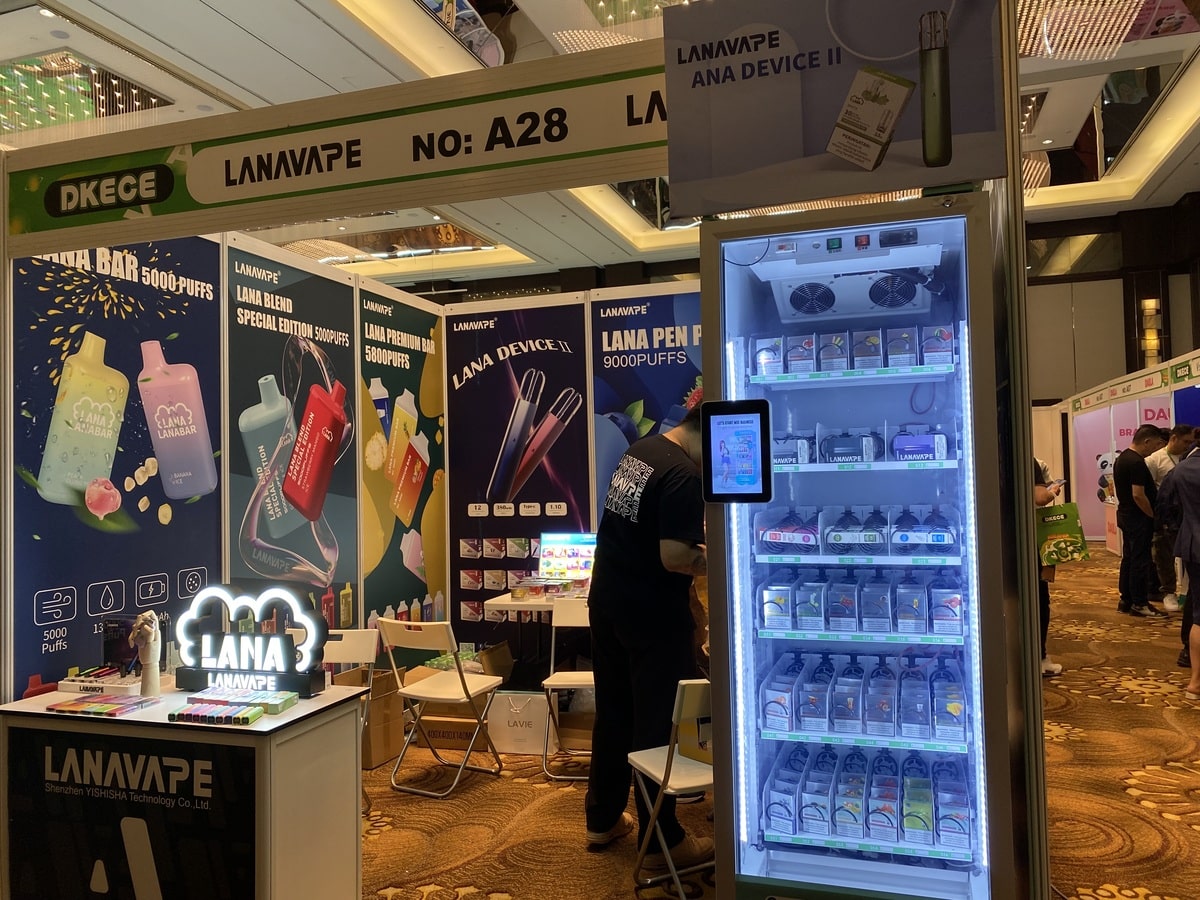KUALA LUMPUR, June 6 — Slim, leggy retail assistants in tight black dresses worked the floor at a vape trade expo here last month, reminiscent of “cigarette girls” touting their wares to customers in nightclubs.
At the 2023 DKECE: International E-Cigarettes Exhibitions Vape Show held at a hotel in the capital city last May 13, foreign e-cigarette and vape manufacturers, mostly from China, promoted their products to local distributors in their aim to penetrate the Malaysian market.
The crowd at the e-cigarette trade exhibition was mixed, with vape distributors, regular vapers, and TikTok influencers who do vape reviews. Enthusiastic vapers lined up for free pens, pods, disposables and testers.
White drifts smelling of strawberry, watermelon, and mint interweaved with voices that blared from speakers throughout the hall. (As tobacco control regulations, including on smoke-free places, exclude e-cigarettes, it’s not illegal to vape indoors in public venues).
This was DKECE’s second vape expo in Malaysia; its first after the delisting of liquid nicotine from the Poisons Act 1952 in an order gazetted by Health Minister Dr Zaliha Mustafa last March 31 that made e-cigarettes and vape legal for all, including minors aged below 18.
Malaysia’s legalisation of nicotine vape for taxation purposes – without accompanying restrictions on sale to children or teenagers; regulations on advertising, packaging and labelling; or other sales and product restrictions – turned out to be a bonanza for foreign e-cigarette producers.
Nearly all of the vape companies at the DKECE e-cigarette trade exhibition told CodeBlue that they were now making a beeline for the unregulated Malaysian market because of the government policy declassifying liquid nicotine.
“Yes,” said a representative of Qiwu Technology’s Yooz, the second biggest vape brand in China, when CodeBlue asked him whether Yooz was expanding to Malaysia because of the delisting of liquid and gel nicotine.
This answer of “yes” and “of course” was the common answer given to CodeBlue when this question was posed to other vape companies at the expo. Sales representatives and managers were extremely aware of the legalisation of liquid nicotine and the potential passage of the tobacco control bill.
The only time when the affirmative answer was not given was when the sales representative did not understand the question or was trying to be tactful about the answer. Out of the 15 companies CodeBlue posed this question to, only two did not say yes.

“Now, we just focus on Southeast Asia. We do Vietnam, Thailand. In 2019, we launched to Malaysia, but it did not work,” said the Yooz representative.
Yooz – although a large player in China, Europe, and the United States – has yet to see much success in Malaysia, with many of the vape shops not featuring or recommending their products. Nonetheless, the industry giant remains undeterred and came back to Malaysia to push its Yooz mini and uni devices and pods.
The representative, who declined to be named, stated that Yooz is betting on the design and price of its products to help it succeed in the Malaysian market.
“Younger people – I think they will change to vaping because it’s cheaper compared to tobacco. Our branding is more for young people, so [we have] elegant styling.
“Our ceramic [pod], two pieces are around RM58 [and] the mini starter kit is RM35. Inside, got the device and two mini pods. So, our product is cheap, not expensive.”
While Yooz’s starter kit is one of the cheapest on the market, the price of their ceramic pods is by no means cheap.
Ceramic pods are not something that is exclusive to Yooz, and in Malaysia, RELX Malaysia is one of the biggest Chinese companies to utilise ceramic pods. These pods have a ceramic coil which gives the pods their name and users a richer and purer flavour, as the coils can withstand more heat and contain nothing that should interact with the coil.
RELX sells their ceramic Pod Pro at RM14 per piece, according to their website. This makes two pods costing RM28, which is RM30 cheaper than Yooz’s.
Like Yooz, many of the vape companies at the trade exhibition touted cheaper prices and better flavours as their main competitive edge. As with other e-cigarettes on the market, nicotine content ranged from two (20mg/ml) to five (50mg/ml) per cent, with the most common percentage being three per cent (30mg/ml).
The e-cigarette trade expo was a mix of foreign manufacturers already established in Malaysia, who were marketing new products and conducting market testing, as well as companies new to the Malaysian market who were focused on getting local distributors.
Most of the exhibitors were vape manufacturers from China, except one from the US.
Vape Flavours: Malays Like Sweet, Chinese Prefer Cold, Indians in Between

Citi by Shenzhen Huayucheng Communication Limited is another company from Shenzhen, China attempting to enter the Malaysian market.
Eden, its sales specialist, told CodeBlue that the company has over nine years of experience in producing disposable vapes and has designed their current line of products specifically for the Malay market in Malaysia.
“We are launching our new products and want to promote our products in Malaysia. Just want to expand our market. Because our new product is designed for Malaysians: sweet but not too cool. It’s for the Malay market,” said Eden.
Citi brings more of the same flavours as other vape companies. Rifting off popular drinks and food that Malaysians enjoy, the company has taro ice cream, strawberry Yakult, and pineapple coconut ice, amongst other flavours.
Although the design and flavours of the products are comparatively bland, Citi is offering to sell their products to distributors at approximately RM19 per piece for their barrel-shaped 10,000-puff disposable vape.
“This is our S13. It is like bubble tea, and this is our new barrel design. This one is RM19,” said Eden.
The disposable vape is a 10,000-puff, 15 ml device that comes with a 600mAh battery and type C charging. Eden said that the rate they are giving distributors is dependent on the exchange rate and that distributors need to place a minimum order of 300 pieces.
In Malaysia, most 10,000-puff disposable vapes sell from RM30 to RM40, with the popular Werti GTR selling at RM40 for retail and RM29 for resellers, and Voltbars from RM30 to RM35, depending on the retailer.
The majority of e-cigarette companies from China at the trade exhibition stated that they are targeting ethnic Malay and Chinese demographics in Malaysia, showcasing different products and e-liquid flavours based on ethnic market segmentation.
According to them, their market research showed that the Malay demographic tends to enjoy disposable vapes that are “creamy” and sweet, while the ethnic Chinese prefer flavours that are “cold” and not too sweet in pod systems.
When asked about ethnic Indians and other communities, the company representatives said that ethnic Indians and other groups tended to fall into either the Malay or Chinese category.
“We [target] Malay and Chinese. Because they, in terms of flavours, are not the same. Chinese: mostly they like cold. Malays: they like sweet; they don’t like cold. Indian more to Malay, but there are some Indians that are more to Chinese. Indians are right in the middle,” said Saiful Akbar, a representative from Zozo, a vape company from China.
While sales representatives did not talk about gender in their target market, it appears that e-cigarettes are designed to appeal equally to women as men. There were many women among visitors to the expo.
Lavie: Our Milk Carton Vape Design ‘Isn’t Like A Toy’
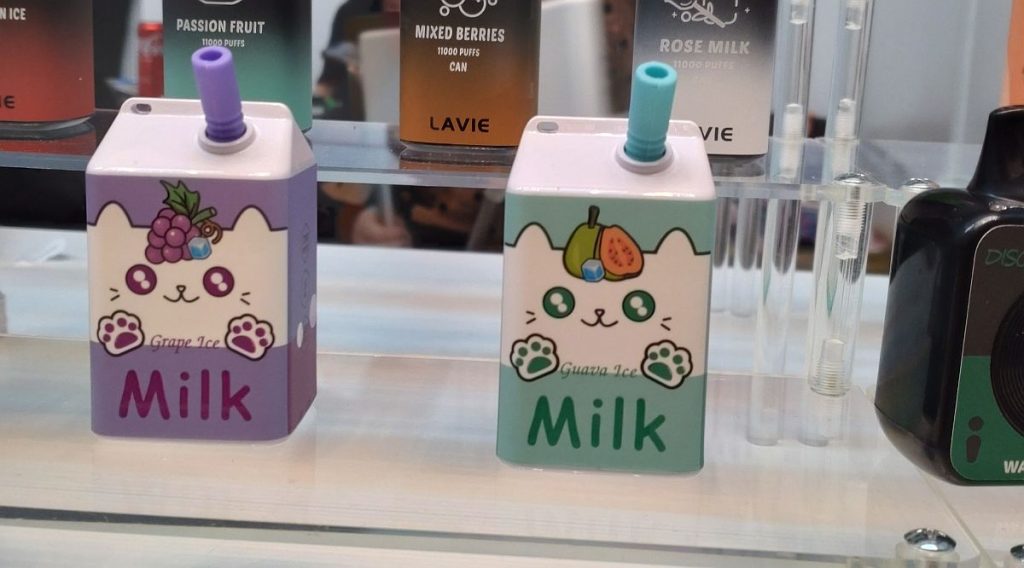
When it came to flavour wars amongst newcomers to the Malaysian market, Lavie by Shenzhen Simeiyue Technology Co. Ltd and Friobar by Freemax were two companies that claimed to bring something new to the table.
Lavie’s representative Rufus Song said that his company’s edge was its product models and flavours.
Focusing on disposable vapes, Lavie’s devices did feel solid and slightly weighty in the hand; its designs were vibrant, with many resembling drink cans, tumblers, and plastic Starbucks frappe cups.
Lavie’s Lavie Milk 7,000-puff disposable vape resembles a milk carton and has an adorable image of a white cat on the front with the word “milk” in bold. A silicone straw peeks out from the top of the carton and its triangular top has a hole punched through it so that vapers can hang the disposable vape on a lanyard.
Its benign appearance, colourful packaging, and cute cat design could attract young children, especially little girls who might be more drawn to the white cat and pastel colours.
Though Lavie Milk does not strictly resemble a toy, it is small enough to pass as a keychain or accessory that children find desirable.
“No, it is not like a toy or something. If they see this part” — Song pointed to a small cap on the tip of the straw — “[they] will know it is a vape, not like a toy or something else. So [parents] won’t let their children use this.”
The small cap he was referring to would be removed by the vaper before using the product. However, parents or children might not be able to identify the product as a vape device by the small cap alone. In fact, it is likely that they would think that the cap is a part of the design more than anything else.
The flavours that Song said are a strong point for Lavie sound similar to all the other vape flavours found in the market – watermelon ice, cola ice, and cool mint. All of them are common flavours on the market.
But what sets Lavie apart from the rest of the market, Song said, is its partnership with a famous juice factory in China. “So, we can make our flavour best.”
Song declined to provide CodeBlue the name of the juice factory to protect commercial secrets.
Friobar Shifts Sights to Malaysia from US, Europe

Friobar by Freemax, a Chinese e-cigarette manufacturer from Shenzhen, China, was previously focused on the US and European markets, but has now decided to enter the Malaysian market because of the legalisation of nicotine vape products here.
“We have new products, and now, we come to Malaysia. Two years ago, we focused on the America market and the Europe market, but now, we want to make our brand in Malaysia,” Cynthia, a sales specialist for Friobar, told CodeBlue.
Friobar, unlike Lavie, takes a different approach when it comes to flavours. Choosing to focus on flavour delivery and user experience, the company came out with a device that employs two coils instead of one to ensure consistency in flavour.
“This two is also the new product with the dual mesh: the two coils inside. We are the first one to do the dual mesh so the flavours are consistent. Because in the market, with disposables the flavour will run out with the charger, but ours, the flavour is consistent from the first breath to the last,” said Cynthia.
The dual mesh technology, according to Friobar’s website, employs two coils instead of one, giving the products a longer lifespan, stability and steady vapour output.
When vapers first begin to vape with the Friobar disposable, the device will alternate between the coils to produce vapour, but when the vaper is halfway through the device, the coils will work in tandem to ensure that the consistency of the flavour in the aerosol produced is maintained.
Lana Eyes New Sales Channel with Vape Vending Machines
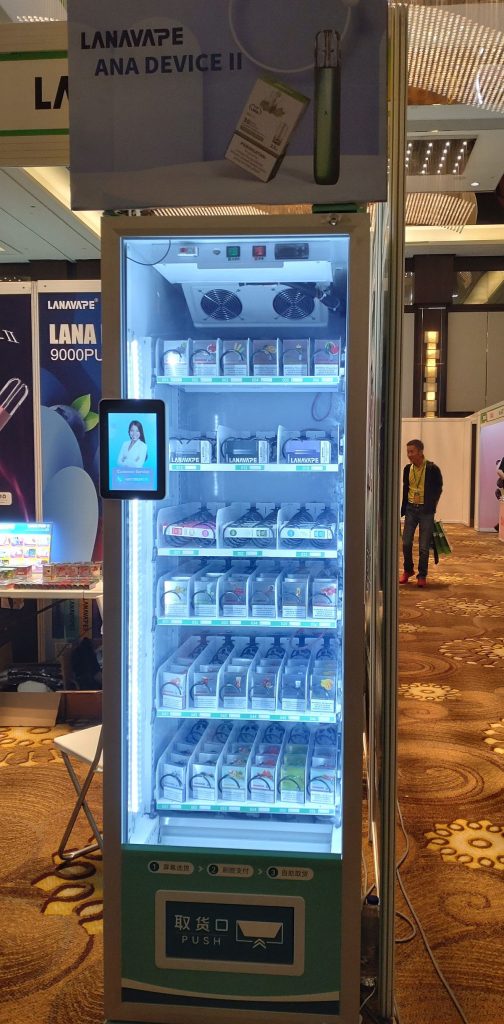
Shenzhen LANA Technology Co., Limited, or Lana, is a vape manufacturer from China that is looking into vape vending machines after receiving inquiries about them.
Like that of Japanese convenience store Family Mart’s, the vape vending machine features a touchscreen where customers can select the products they want — pods, disposables, or devices — and pay via e-wallet by scanning the QR code on the screen.
“We have a few inquiries about it. So, we put it here to actually see whether it works or not. If it does we might actually put it around. This is just the first here. This is just to try out first,” Carlston, a manager at Lana’s Malaysian branch, told CodeBlue at his booth featuring a vape vending machine.
The success of the machine could see more vapers than ever in Malaysia, as the devices could be placed at high-traffic areas such as train stations, enabling more Malaysians to easily purchase their products. However, the uptick in vapers is not the only danger Malaysia could see with the vending machine.
On the current rendition of the machine, there is nothing that prevents children from purchasing vape products. Carlston told CodeBlue that this is one of the reasons why Lana has yet to introduce the vape vending machine to the market.
“We have not found a way [to prevent minors from purchasing vape] yet. That is why for now, you can’t see it. Until we solve that issue, then we will see how things go from there.
“Maybe through the government [or] any department that we can go to propose to, because we don’t want this (the machine) to get confiscated as well.
“But we don’t want minors to vape as well, we don’t encourage them. So, we try to find a way through that. So hopefully, in a few months’ time we’ll find a way.”
Carlston said that Lana takes the sale of vapes to minors extremely seriously and refuses to supply any retailer that sells e-cigarettes to minors, sometimes sending mystery shoppers to retailers they deal with.
“It is a hundred per cent no, no for kids. There is a warning on the product and all that. If there are any shops we know that they are selling to minors, we cancel them.
“People come and report it to us. Or maybe sometimes, we have people who just enter the shops and just check around. Let’s say they (the shops) do (sell to minors), they (the mystery shopper) will report to my side, then I will get someone to actually contact them (the shop) to tell them that that’s the last time they are holding our products. The next time they order, we are not supplying them,” Carlston said.
The closest thing to vape vending machines is the cigarette vending machines of Japan. According to Reuters, Japan’s cigarette vending machines require a smart card called “taspo” (an amalgamation of the words ‘tobacco’, ‘access’ and ‘passport’), which is issued only to people who are 20 (the legal smoking age) and above.
In addition to functioning as an ID, the card acts as an electronic money card for the machine. To get the card, smokers need to send their identification papers to the Tobacco Institute of Japan.
The National Health and Morbidity Survey (NHMS) 2022 revealed a significant increase in the prevalence of current e-cigarette and vape use among Malaysian teenagers aged 13 to 17 from 9.8 per cent in 2017 to 14.9 per cent in 2022, even higher than the United States.
Increasing Requests to Stock Vape in Convenience Stores, Mobile Accessory Shops, and Restaurants
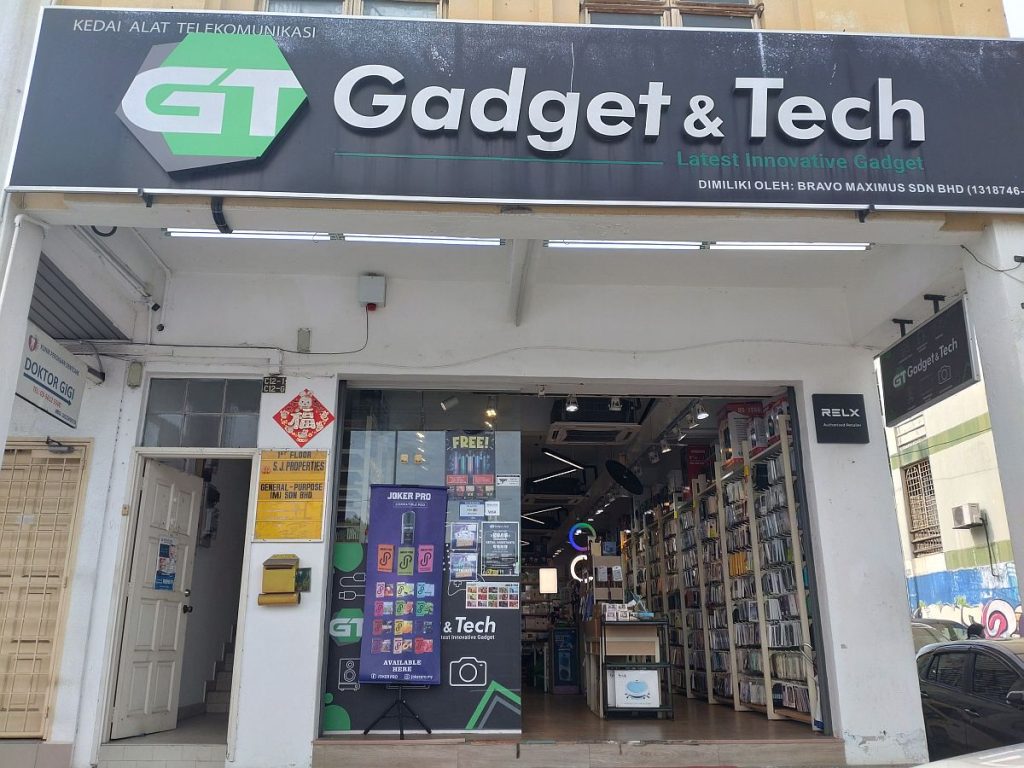
According to Carlston, the Malaysian vape market is growing more convenient for the vape industry to conduct business. Lana has been seeing more traffic from retailers, including convenience stores and restaurants.
“[The market in Malaysia] – it is getting better. It is getting a lot more convenient now. We are not too sure how it is going to be later on, but for now, it is quite positive.
“I’m getting a lot more requests, a lot more vape shops are calling us, not just vape shops, convenience stores are calling us as well. We try to enter through Ninjaz. They carry Lana as well. Even Morganfield has it as well,” Carlston said.
“If they (restaurants) want it, sure, not a problem. We approach them, and we ask them if they want to carry it (vapes), and they say, yes. So, it is not an issue. It is like how they used to sell cigarettes, they had the cigarette box right, so now things have changed. They want additional things to sell there.”
Ninjaz is a chain mobile accessory shop that stocks its vape products behind the counter. They, however, are not the only shop to dip into the vape industry. Other stores such as Gadget and Tech (a mobile accessory chain) and MiX.com (an Asian snack importer and retail chain) have also been selling vapes for a number of years in Malaysia.
Morganfield’s is a diner.
SP2S Creates New Company To Rival Lana
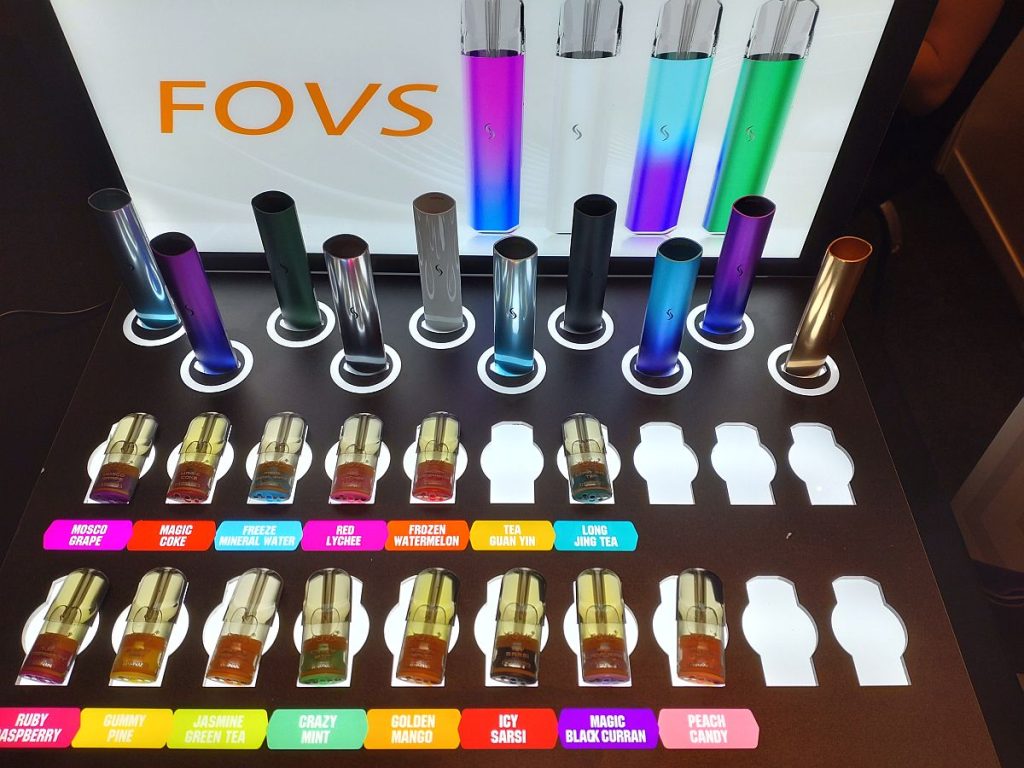
FOVS, a subsidiary of Shenzhen SP2S Technology Co., was created to compete against Lana. As Lana’s flavours are cold, FOVS also focuses on cold flavours that are popular amongst the ethnic Chinese demographic. Thus, they are targeting only the Chinese demographic in Malaysia.
“For Chinese people, our product – 80 per cent I think can sell because most of the Chinese people like cold and also flavouring, but it’s very hard to sell to Malay all this because they don’t like cold; they just like sweet.
“Our products are only cold. For now, it is Chinese user. Maybe in the future, we will do some sweet tea flavour, but not that cold,” FOVS sales and service executive Jayden Yeap told CodeBlue.
The FOVS products use the same product design and pod system as SP2S. Products from companies have the same slim, gradient vape pens and translucent acrylic mouthpieces. However, unlike SP2S’s vape pens which don’t light up, the FOVS’s pens have a line of LEDs that run up from the base of the device to halfway up its side, giving the device a Tron-esque futuristic look when vapers inhale a breath of aerosol.
“[FOVS has the] same boss as SP2, and why this product they want to come out is because she want to fight the market with the Lana pods. Because Lana vape is cheaper and also can use for the SP2S device, so our boss, she wants to come out with a new product to fight Lana vape, and this pricing is cheaper,” Yeap said.
“For selling price, around RM29 [for the pods]. For the device, we still don’t know yet. Estimate is next month came out all the things, so then only will launch all the pricing.
“Today, we just want to launch [our products] to let any user, dealer or any reseller, manufacturers, let them know we are selling our product here (Malaysia), and let them try the testers.”
The RM29 price tag is for a box of three 2ml FOVS pods. This is RM10 cheaper for the same box of SP2S pods is around the price range of Lana pods, which are between RM20 to RM30, depending on the retailer.
When asked what makes FOVS better than Lana, Yeap said they excel when it comes to their flavours. “For Lana, it is the cold only, but the flavouring is not that good.”
Stakeholders could easily pick up any of the 15 flavours on display and try them out. Staff at the booth would wipe the mouthpiece with a piece of tissue and hand them to interested consumers — who had no qualms about placing the devices into their mouths and sucking in a breath.
The University of Colorado at Boulder states that sharing vapes can expose users to a number of diseases like the cold, flu, Covid, mono or meningitis, which can all be transferred from person to person through saliva.
Hybrid Disposables With Closed Pods On The Rise
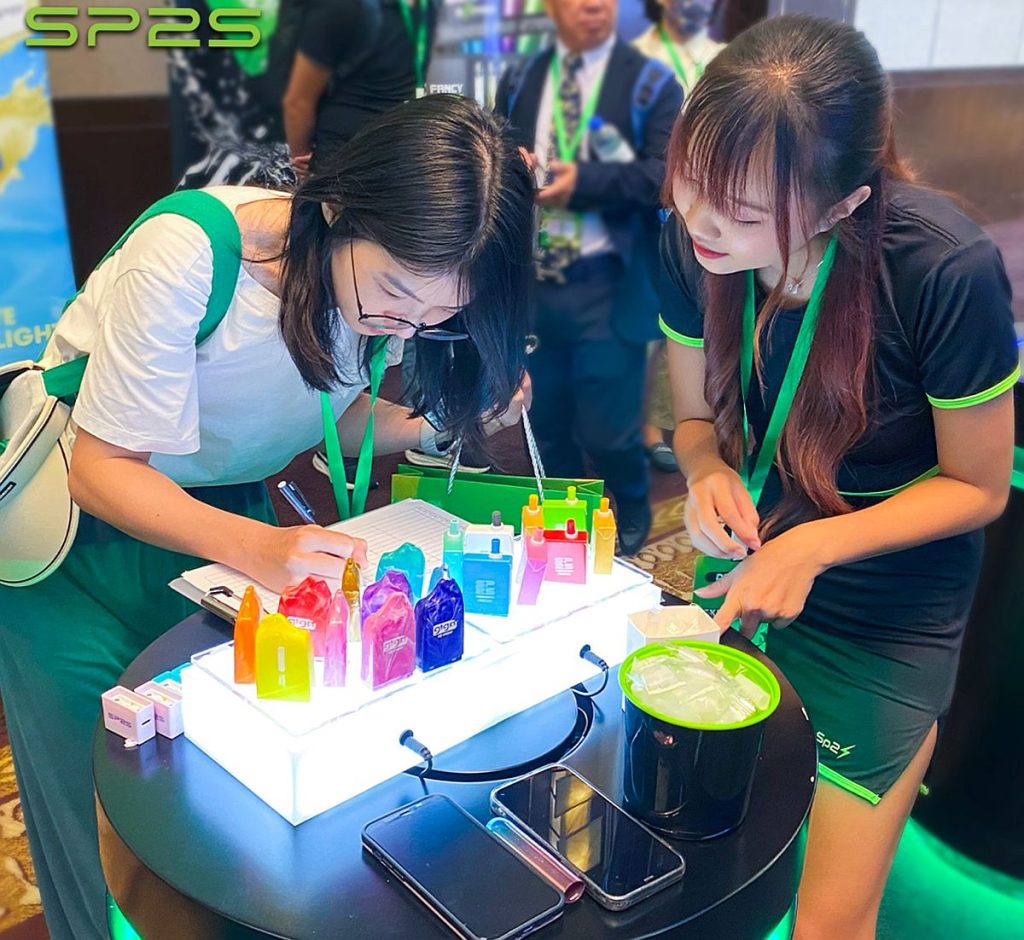
Hybrid disposable devices modelled after the Elf Bar Lowit are on the rise.
The Elf Bar Lowit at its heart is a closed system pod, however, the device resembles and is marketed as a disposable vape with a rechargeable, reusable battery.
Therefore, unlike a traditional disposable, which can be charged but is thrown away once the liquid runs out, the Elf Bar Lowit’s battery can be detached from the disposable pod once the e-liquid runs out. Vapers can then attach a new pod to the battery and continue vaping.
A traditional closed pod system pen, like the SP2S’s Legendaa vape pens, would have 2ml of vape liquid in its pods, meaning users have approximately 600 puffs before they need to replace the pod. With the hybrid Lowit devices, vapers have 5,500 puffs before they need to swap out the pod, and the number of puff vapers have is only set to rise.
SP2S, a vape company from Shenzhen, China, introduced their Giga and Giga Bite devices at the expo. The only difference between the Giga and Giga Bite are the flavours. The Giga pods, targeted at the Chinese market, have cold and minty e-liquids, while the Giga Bite pods are targeted at the Malay market with creamy and sweet flavours. They both utilise the same battery housing that comes in a variety of colours, allowing users a degree of customisation.
The pod has 10ml of e-liquid, offering users 6,500 puffs, which is 1,000 puffs more than the Elf Bar Lowit.
The prices of the Giga and Giga Bite have yet to be released by SP2S, but as it is a direct competitor to the Elf Bar Lowit starter kit, which is a 5,500-puff device and costs between RM20 to RM30, one can expect SP2S to come up with a similar price for their “disposable” pod kit.
ZOVOO Targets Youths With Trendy E-Cigarettes, Not Existing Smokers: ‘Older People Won’t Accept Vape’
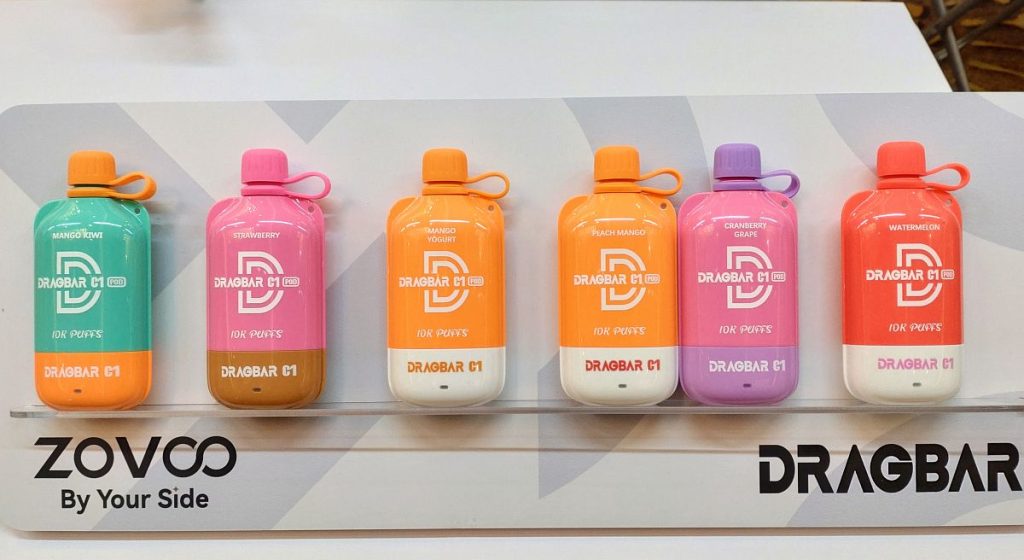
SP2S was not the only company to capitalise on the popularity of the Lowit design. ZOVOO (Shenzhen) Technology Co.,Ltd, a vape company from China, came out with the Dragonbar C1 and C1 Pod, yet another detachable disposable device.
The device goes big with its capacity, offering users a 10,000-puff disposable pod in 10 different flavours and multiple colours packaged in small bottles that resemble Ribena packets. This is one of the few devices to come with a cap, so that users can cover the device’s mouthpiece when not using the device.
The rising popularity of these hybrid devices would pose a problem to new vapers who do not understand the subtleties between pods and disposables. As the device is a hybrid device, new users who might be trying vaping out of curiosity could find themselves stuck with a new habit.
Unlike disposables that can be thrown away, buyers are stuck with one part of the device and could be tempted into purchasing yet another pod for the device. And retailers and companies are capitalising on naivete.
The sales representative at ZOVOO openly stated that the company was targeting youths as opposed to existing smokers.
“Confirm no. (Smokers won’t switch) because, for example, this one (the Dragonbar C1) is smaller, younger, and trendy. For older people, they will not accept this one. People like them (youngsters) purchase this to follow the trend. Maybe you just bring it out and show off vaping with friends, something like that,” the ZOVOO sales representative, who declined to be named, told CodeBlue.
Vaping is a massive industry in Malaysia. In late February, The Edge reported that the industry had grown RM2.49 billion in the year 2022 — a 9.7 per cent jump in the span of three years. The Edge reported that despite the pandemic forcing many vape stores to close, the industry found other channels to sell their products.
World Health Organization (WHO) director-general Tedros Adhanom Ghebreyesus told a media briefing last Friday that e-cigarettes and vape are a “trap” to recruit children from an early age for a lifetime of addiction, not harm reduction as claimed by the tobacco industry.
The WHO chief also stated that vaping is harmful in itself, as he urged Malaysia and other countries to “protect your citizens, especially your children” by regulating these nicotine products.
Health Policy Watch, a health news organisation based in Geneva, Switzerland, described Tedros’ remarks – which were made in response to CodeBlue’s question on the impact of Malaysia’s decision to legalise e-cigarettes and vape without restrictions – as “one of the sharpest rebukes of the industry yet”.
While the vape industry is expanding its territory in Malaysia, the future of the Control of Smoking Product for Public Health Bill 2023 remains unclear, even as it is scheduled to be tabled in the Dewan Rakyat this week.
CodeBlue reported that the Cabinet has decided to have the tobacco and vape control bill referred to a parliamentary special select committee after it is tabled in Parliament, potentially further delaying vote and passage of the bill to the following October parliamentary meeting.
If the bill (and its subsidiary regulations) are further delayed, this means that everything at the 2023 DKECE e-cigarette trade exhibition will continue to remain completely legal in Malaysia for months or even a year to come – the cute disposable vape designed like a milk carton, vape vending machines, and the creation of increasingly yummy flavours in “flavour wars” to entice youths across gender.
All for the sake of some tax ringgit.


